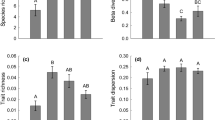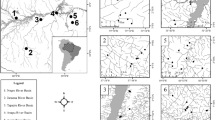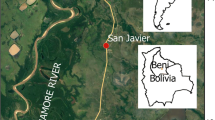Abstract
Metacommunities are spatially structured communities linked by dispersal. They provide a connection between local community assembly and regional-level processes. One of the more widely used methods to address questions related to metacommunity concepts is those that characterize elements of metacommunity structure by quantifying aspects of coherence, species turnover, and boundary clumping. In this study, we used this approach to study the spatial ecology of freshwater fishes in Texas. Stream-fish assemblages in Texas provide an excellent opportunity to examine the patterns of metacommunity structure due to the number of drainages that empty directly into the Gulf of Mexico, which minimizes the likelihood of dispersal between basins while allowing for longitudinal movement within basins. We used fisheries data published by the Texas Parks and Wildlife Department and from the North American Water Quality Association, which consisted of 94 sampling localities distributed across 18 river basins and 11 ecoregions. To examine within-basin patterns, we focused only on the Brazos, Colorado, and Trinity rivers because of the number of sites within each of these basins. From a taxonomic standpoint, we consistently observed Clementsian patterns regardless of whether it was among or within river basins, whereas we mostly observed Gleasonian patterns from a functional perspective. Only one functional group was found at all sites in each of the three main river basins, which consisted of invertivores with an equilibrium life-history strategy. Various bioclimatic variables were significantly correlated with metacommunity structure, but these correlations differed between taxonomic and functional organization and differed depending on which river basin was considered. The results of this study support previous findings that species composition and functional traits relate to environmental gradients, but further our understanding by providing additional evidence that species sorting processes are the dominant structuring mechanisms.


Similar content being viewed by others
References
Altermatt F (2013) Diversity in riverine metacommunities: a network perspective. Aquat Ecol 47:365–377
Anderson AA, Hubbs C, Winemiller KO, Edwards RJ (1995) Texas freshwater fish assemblages following three decades of environmental change. Southwest Nat 40:314–321
Bertuzzo E, Muneepeerakul R, Lynch HJ, Fagan WF, Rodriguez-Iturbe I, Rinaldo A (2009) On the geographic range of freshwater fish in river basins. Water Resour Res 45:W11420. doi:10.1029/2009WR007997
Borthagaray AI, Pinelli V, Berazategui M, Rodriguez-Tricot L, Arim M (2015) Effects of metacommunity networks on local community structures: from theoretical predictions to empirical evaluations. In: Belgrano A, Woodward G, Jacob U (eds) Aquatic functional biodiversity: an ecological and evolutionary perspective. Academic Press, Cambridge, pp 75–111
Carrara F, Altermatt F, Rodriguez-Iturbe I, Rinaldo A (2012) Dendritic connectivity controls biodiversity patterns in experimental metacommunities. Proc Natl Acad Sci 109:5761–5766
Clements FE (1916) Plant succession: an analysis of the development of vegetation. Carnegie Institution of Washington, Washington, DC
Cook RR, Angermeier PL, Finn DS, Poff NL, Krueger KL (2004) Geographic variation in patterns of nestedness among local stream fish assemblages in Virginia. Oecologia 140:639–649
Cottenie K, Michels E, Nuytten N, De Meester L (2003) Zooplankton metacommunity structure: regional vs local processes in highly interconnected ponds. Ecology 84:991–1000
De’ath G, Fabricius KE (2000) Classification and regression trees: a powerful yet simple technique for ecological data analysis. Ecology 81:3178–3192
De Bie T, De Meester L, Brendonck L, Martens K, Goddeerls B, Ercken D, Hampel H, Denys L, Vanhecke L, Van der Gucht K, Van Wichelen J, Vyverman W, Declerck SAJ (2012) Body size and dispersal mode as key traits determining metacommunity structure of aquatic organisms. Ecol Lett 15:740–747
de la Sancha NU, Higgins CL, Presley SJ, Strauss RE (2014) Metacommunity structure in a highly fragmented forest: has deforestation in the Atlantic Forest altered historic biogeographic patterns? Divers Distrib 20:1058–1070
De'ath G, Fabricius KE (2000) Classification and regression trees: a powerful yet simple technique for ecological data analysis. Ecology 81:3178-3192 Diamond JM (1975) Assembly of species communities. In: Cody ML, Diamond JM (eds) Ecology and evolution of communities. Harvard University Press, Cambridge, pp 342–444
Erős T, Sály P, Takács P, Specziar A, Bíró P (2012) Temporal variability in the spatial and environmental determinants of functional metacommunity organization-stream fish in a human-modified landscape. Freshw Biol 57:1914–1928
Erős T, Sály P, Takács P, Higgins CL, Bíró P, Schmera D (2014) Quantifying temporal variability in the metacommunity structure of stream fishes: the influence of non-native species and environmental drivers. Hydrobiologia 722:31–43
Fernandes IM, Henriques-Silva R, Penha J, Zuanon J, Peres-Neto PR (2014) Spatiotemporal dynamics in a seasonal metacommunity structure is predictable: the case of floodplain-fish communities. Ecography 37:464–475
Gauch HG (1982) Multivariate analysis in community ecology. Cambridge University Press, Cambridge
Gleason HA (1926) The individualistic concept of the plant association. Bull Torrey Bot Club 53:7–26
Guimaraes TDFR, Hartz SM, Becker FG (2014) Lake connectivity and fish species richness in southern Brazilian coastal lakes. Hydrobiologica 740:207–217
Habit E, Belk M, Victoriano P, Jaque E (2007) Spatio-temporal distribution patterns and conservation of fish assemblages in a Chilean coastal river. Biodivers Conserv 16:3179–3191
Hanski I, Gilpin M (1991) Metapopulation dynamics: brief history and conceptual domain. Biol J Linn Soc 42:3–16
Heino J (2005) Metacommunity patterns of highly diverse stream midges: gradients, chequerboards, and nestedness, or is there only randomness? Ecol Entomol 30:590–599
Heino J (2013) Does dispersal ability affect the relative importance of environmental control and spatial structuring of littoral macroinvertebrate communities? Oecologia 171:971–980
Heino J, Soininen J (2005) Assembly rules and community models for unicellular organisms: patterns in diatoms of boreal streams. Freshw Biol 50:567–577
Heino J, Melo AS, Siqueira T, Soininen J, Valanko S, Mauricio Bini L (2015a) Metacommunity organisation, spatial extent and dispersal in aquatic systems: patterns, processes and prospects. Freshw Biol 60:845–869
Heino J, Soininen J, Alahuhta J, Lappalainen J, Virtanen R (2015b) A comparative analysis of metacommunity types in the freshwater realm. Ecol Evol 5:1525–1537
Henriques-Silva R, Lindo Z, Peres-Neto PR (2013) A community of metacommunities: exploring patterns in species distributions across large geographical areas. Ecology 94:627–639
Higgins CL (2010) Patterns of functional and taxonomic organization of stream fishes: inferences based on α, β, and γ diversities. Ecography 33:678–687
Higgins CL, Strauss RE (2008) Modeling stream fish assemblages with niche apportionment models: patterns, processes, and scale dependence. Trans Am Fish Soc 137:696–706
Hijmans RJ, Cameron SE, Parra JL, Jones PG, Jarvis A (2005) Very high resolution interpolated climate surfaces for global land areas. Int J Climatol 25:1965–1978
Hoeinghaus DJ, Winemiller KO, Birnbaum JS (2007) Local and regional determinants of stream fish assemblage structure: inferences based on taxonomic vs. functional groups. J Biogeogr 34:324–338
Holyoak M, Leibold M, Holt R (2005) Metacommunities: spatial dynamics and ecological communities. University of Chicago Press, Chicago
Hortal J, Nabout JC, Calatayud J, Carneiro FM, Padial A, Santos AMC, Siqueira T, Boma F, Bini LM, Ventura M (2014) Perspectives on the use of lakes and ponds as model systems for macroecological research. J Limnol 73:46–60
Hoverman JT, Davis CJ, Werner EE, Skelly DK, Relyea RA, Yurewicz KL (2011) Environmental gradients and the structure of freshwater snail communities. Ecography 34:1049–1058
Ibarra AA, Park YS, Brosse S, Reyjol Y, Lim P, Lek S (2005) Nested patterns of spatial diversity revealed for fish assemblages in a west European river. Ecol Freshw Fish 14:233–242
Jacobson B, Peres-Neto PR (2010) Quantifying and disentangling dispersal in metacommunities: how close have we come? How far is there to go? Landscape Ecol 25:495–507
Lamouroux N, Poff NL, Angermeier PL (2002) Intercontinental convergence of stream fish community traits along geomorphic and hydraulic gradients. Ecology 83:1792–1807
Leibold M, Mikkelson G (2002) Coherence, species turnover, and boundary clumping: elements of meta-community structure. Oikos 97:237–250
Leibold MA, Holyoak M, Mouquet N, Amarasekare P, Chase JM, Hoopes MF, Holt RD, Shurin JB, Law R, Tilman D, Loreau M, Gonzalez A (2004) The metacommunity concept: a framework for multi-scale community ecology. Ecol Lett 7:601–613
Leibold MA, Economo EP, Peres-Neto PR (2010) Metacommunity phylogenetics: separating the roles of environmental filters and historical biogeography. Ecol Lett 13:1290–1299
Linam GW, Kleinsasser LJ, Mayes KB (2002) Regionalization of the index of biotic integrity for Texas streams. River Studies Report No. 17. Resource Protection Division, Texas Parks and Wildlife Department, Austin, TX
Logue JB, Mouquet N, Peter H, Hillebrand H, The Metacommunity Working Group (2011) Empirical approaches to metacommunities: a review and comparison with theory. Trends Ecol Evol 26:482–491
Loh W (2011) Classification and regression trees. Data Min Knowl Disc 1:14–23
Lopez-Gonzalez C, Presley SJ, Lozano A, Stevens RD, Higgins CL (2012) Metacommunity structure of Mexican bats: a test of metacommunity paradigms in an area of high geographic and environmental complexity. J Biogeogr 39:177–192
Muneepeerakul R, Bertuzzo E, Lynch HJ, Fagan WF, Rinaldo A, Rodriguez-Iturbe I (2008) Neutral metacommunity models predict fish diversity patterns in Mississippi–Missouri basin. Nature 453:220–222
Oberdorff T, Guilbert E, Lucchetta JC (1993) Patterns of fish species richness in the Seine River basin, France. Hydrobiologia 259:157–167
Ostrand KG, Wilde GR (2002) Seasonal and spatial variation in a prairie stream-fish assemblage. Ecol Freshw Fish 11:137–149
Patterson BD, Atmar A (1986) Nested subsets and the structure of insular mammalian fauna and archipelagos. Biol J Linn Soc 28:65–82
Perkin JS, Gido KB (2012) Fragmentation alters stream fish community structure in dendritic ecological networks. Ecol Appl 22:2176–2187
Pianka ER (1970) On r- and K-selection. Am Nat 104:592–597
Poff NL (1997) Landscape filters and species traits: towards mechanistic understanding and prediction in stream ecology. J North Am Benthol Soc 16:391–409
Presley SJ, Higgins CL, López-González C, Stevens RD (2009) Elements of metacommunity structure of Paraguayan bats: multiple gradients require analysis of multiple ordination axes. Oecologia 160:781–793
Presley SJ, Higgins CL, Willig MR (2010) A comprehensive framework for the evaluation of metacommunity structure. Oikos 119:908–917
Presley SJ, Willig MR, Bloch CP, Castro-Arellano I, Higgins CL, Klingbeil BT (2011) A complex metacommunity structure for gastropods along an elevational gradient: axes of specialization and environmental variation. Biotropica 43:480–488
Ricklefs RE (2004) A comprehensive framework for global patterns in biodiversity. Ecol Lett 7:1–15
Rodriguez-Iturbe I, Muneepeerakul R, Bertuzzo E, Levin SA, Rinaldo A (2009) River networks as ecological corridors: a complex systems perspective for integrating hydrologic, geomorphologic, and ecologic dynamics. Water Resour Res 45:1–22
Schlosser IJ (1982) Fish community structure and function along two habitat gradients in a headwater stream. Ecol Monogr 52:395–414
Schwalb AN, Morris TJ, Cottenie K (2015) Dispersal abilities of riverine freshwater mussels influence metacommunity structure. Freshw Biol 60:911–921
Simberloff D (1983) Competition theory, hypothesis testing, and other community ecological buzzwords. Am Nat 122:626–635
Simberloff D, Dayan T (1991) The guild concept and the structure of ecological communities. Annu Rev Ecol Syst 22:115–143
Sokol ER, Benfield EF, Belden LK, Valett HM (2011) The assembly of ecological communities inferred from taxonomic and functional composition. Am Nat 177:630–644
Southwood T (1977) Habitat, the templet for ecological strategies? J Anim Ecol 46:337–365
Tilman D (1982) Resource competition and community structure. Princeton University Press, Princeton
Tornwall B, Sokol E, Skelton J, Brown BL (2015) Trends in stream biodiversity research since the river continuum concept. Diversity 7:16–35
Townsend CR, Hildrew AG (1994) Species traits in relation to a habitat templet for river systems. Freshw Biol 31:265–275
Urban DL (2002) Classification and regression trees. In: McCune B, Grace JB (eds) Analysis of ecological communities. MJM Press, Gleneden Beach, pp 222–232
Urban MC, Leibold MA, Amarasekare P, De Meester L, Gomulkiewicz R, Hochberg ME, Klausmeier CA, Loeuille N, de Mazancourt C, Norberg J, Pantel JH, Strauss SY, Vellend M, Wade MJ (2008) The evolutionary ecology of metacommunities. Trends Ecol Evol 23:311–317
Van Looy K, Tormos T, Souchon Y (2014) Disentangling dam impacts in river networks. Ecol Ind 37:10–20
Vannote RL, Minshall GW, Cummins KW, Sedell JR, Cushing CE (1980) The river continuum concept. Can J Fish Aquat Sci 37:130–137
Wilson DS (1992) Complex interactions in metacommunities, with implications for biodiversity and higher levels of selection. Ecology 73:1984–2000
Winemiller KO (1992) Life-history strategies and the effectiveness of sexual selection. Oikos 63:318–327
Winemiller KO (1995) Fish ecology. In: Nierenberg WA (ed) Encyclopedia of environmental biology, vol 2. Academic Press, San Diego, pp 49–65
Winemiller KO (2005) Life history strategies, population regulation, and implications for fisheries management. Can J Fish Aquat Sci 62:872–885
Winemiller K, Rose K (1992) Patterns of life-history diversification in North American fishes: implications for population regulation. Can J Fish Aquat Sci 49:2196–2218
Author information
Authors and Affiliations
Corresponding author
Additional information
Handling Editor: Thomas Mehner.
Electronic supplementary material
Below is the link to the electronic supplementary material.
Rights and permissions
About this article
Cite this article
Medina Torres, K.M., Higgins, C.L. Taxonomic and functional organization in metacommunity structure of stream-fish assemblages among and within river basins in Texas. Aquat Ecol 50, 247–259 (2016). https://doi.org/10.1007/s10452-016-9572-5
Received:
Accepted:
Published:
Issue Date:
DOI: https://doi.org/10.1007/s10452-016-9572-5




